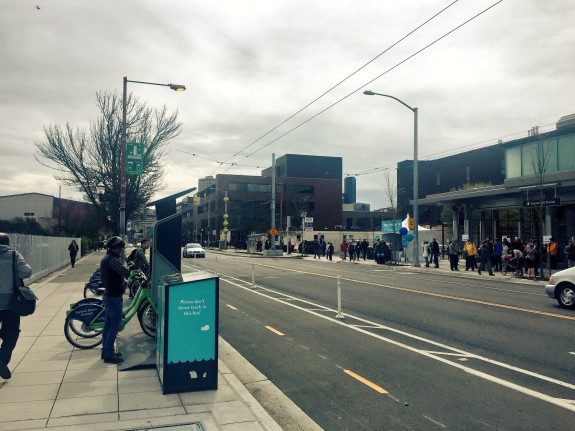With U Link, combining bikes and transit just got even more powerful

Bike valet! If only this were permanent or replaced with another more secure option.

UW loaned these old-style staple racks while Sound Transit works to install more permanent and modern staple racks in addition to the "coat hanger" racks already installed.
University of Washington Station opened Saturday and immediately assumed its role as the bikiest light rail station in the region.
The bike parking was overflowing during Saturday's opening celebration. Even the additional free valet bike parking space provided for the day was handlebar-to-handlebar.
And it makes sense, UW Station is only a stone's throw from the Burke-Gilman Trail, likely our state's busiest walking and biking trail. Not only that, but the segment of the trail through UW campus was already the busiest section of the trail before the light rail opened, moving about as many people during a busy commute hour as a lane of a freeway.
UW saw this coming, which is why they have been working for years to remake the trail in the station area. The area connecting to the station (dubbed Rainier Vista) was completed last year, providing an underpass trail for people continuing through and creating new access points from the station into campus and to the trail. Unfortunately, work on the section of trail west of the station is still under construction and isn't scheduled to reopen until the summer. At this point, it has been two years since the trail was fully and consistently open through UW.
Even with construction, the trail and other bike routes bring a huge number of homes and destinations within easy reach of UW Station. The station location is not very good for walkable access to the U District business center or much of campus, but it is very bikeable. Very dense parts of the U District, North University and Wallingford areas are within a ten-minute bike ride from the station - not to mention the U Village shopping center - as estimated in this map from WalkScore:
The result is even more dramatic when you increase biking time to 15 minutes:
These maps may also provide a bit of insight into the potential reach of Pronto in the next expansion. And on that note, a Pronto Station at UW Station can't come soon enough (the closest station is a two minute walk away across a busy street and out of view of the station itself). The good news is that a better station location is in the works.
Oddly enough, someone going from Fremont to Capitol Hill may be better off biking all the way to UW Station and taking light rail (20+ minutes depending on train arrival and biking speed, according to Google Maps) versus biking or taking the bus the whole way (30+ minutes each). From Ballard to Capitol Hill, it's 45+ minutes by bike or bus, but you could make the trip in 30+ minutes by biking to UW Station.
Combining bikes and transit just got a lot more powerful.

Pronto crews worked late into the night to move this station before the Saturday grand opening. Sorry First Hill, you had to take one for the team. First Hill needs full coverage of stations in the next expansion.
Capitol Hill Station is a slightly different story. Much of its easy bike reach is better served by other stations either due to proximity or topography (if you're in Madison Valley, biking up that mega hill just to get to light rail may make less sense than just biking to UW Station, for example). It's biggest bike access potential lies in the Central District and other dense areas just out of an easy walk.
Below are the maps from WalkScore. This is a very strong argument for a Central District Pronto expansion:

 Secure bike parking at Capitol Hill Station is also very needed, but probably not on the scale of UW Station with its Burke-Gilman access. There were a good number of bikes at Capitol Hill Station for the launch party Saturday, but nowhere near as many as showed up to UW Station.
Secure bike parking at Capitol Hill Station is also very needed, but probably not on the scale of UW Station with its Burke-Gilman access. There were a good number of bikes at Capitol Hill Station for the launch party Saturday, but nowhere near as many as showed up to UW Station.
A lot of people are going to want to combine biking and transit. And without secure and convenient bike parking and/or expanded bike share, many people are going to want to bring their bikes on the train. But bringing bikes on the train is not a solution that scales well. If a couple people do it per train, it's not a big deal (Sound Transit's rules say four per train car), but demand (especially during rush hour) will likely outpace this limit. Train cars with a more open design can help, too, and are in the works for the next purchase.
Of course, big demand from people biking to transit is a great problem to have.

